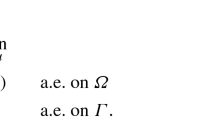Abstract
Elliptic optimal control problems with L 1-control cost are analyzed. Due to the nonsmooth objective functional the optimal controls are identically zero on large parts of the control domain. For applications, in which one cannot put control devices (or actuators) all over the control domain, this provides information about where it is most efficient to put them. We analyze structural properties of L 1-control cost solutions. For solving the non-differentiable optimal control problem we propose a semismooth Newton method that can be stated and analyzed in function space and converges locally with a superlinear rate. Numerical tests on model problems show the usefulness of the approach for the location of control devices and the efficiency of our algorithm.
Similar content being viewed by others
References
Adams, R.A.: Sobolev Spaces. Academic Press, New York (1975)
Ascher, U.M., Haber, E., Huang, H.: On effective methods for implicit piecewise smooth surface recovery. SIAM J. Sci. Comput. 28(1), 339–358 (2006)
Bergounioux, M., Ito, K., Kunisch, K.: Primal-dual strategy for constrained optimal control problems. SIAM J. Control Optim. 37(4), 1176–1194 (1999)
Bertsekas, D.P.: Nonlinear Programming. Athena Scientific, Belmont (1999)
Chan, T.F., Tai, X.-C.: Identification of discontinuous coefficients in elliptic problems using total variation regularization. SIAM J. Sci. Comput. 25(3), 881–904 (2003)
Chen, X., Nashed, Z., Qi, L.: Smoothing methods and semismooth methods for nondifferentiable operator equations. SIAM J. Numer. Anal. 38(4), 1200–1216 (2000)
Clarke, F.H.: Optimization and Nonsmooth Analysis. Canadian Mathematical Society Series of Monographs and Advanced Texts. Wiley, New York (1983)
Costa, L., Figueiredo, I.N., Leal, R., Oliveira, P., Stadler, G.: Modeling and numerical study of actuator and sensor effects for a laminated piezoelectric plate. Comput. Struct. 85(7–8), 385–403 (2007)
Davis, T.A., Hager, W.W.: A sparse proximal implementation of the LP dual active set algorithm. Math. Program. (2007). doi:10.1007/s10107-006-0017-0
Durand, S., Nikolova, M.: Stability of the minimizers of least squares with a non-convex regularization. I. Local behavior. Appl. Math. Optim. 53(2), 185–208 (2006)
Ekeland, I., Temam, R.: Convex Analysis and Variational Problems. North-Holland, Amsterdam (1976)
Figueiredo, I.N., Leal, C.: A piezoelectric anisotropic plate model. Asymptot. Anal. 44(3–4), 327–346 (2005)
Gilberg, T., Trudinger, N.S.: Elliptic Partial Differential Equations of Second Order. Springer, Berlin (1983)
Glowinski, R.: Numerical Methods for Nonlinear Variational Inequalities. Springer, New York (1984)
Grund, T., Rösch, A.: Optimal control of a linear elliptic equation with a supremum-norm functional. Optim. Methods Softw. 15, 299–329 (2001)
Hager, W.W.: The dual active set algorithm. In: Pardalos, P.M. (ed.) Advances in Optimization and Parallel Computing, pp. 137–142. North-Holland, Amsterdam (1992)
Hager, W.W.: The dual active set algorithm and its application to linear programming. Comput. Optim. Appl. 21(3), 263–275 (2002)
Hager, W.W., Hearn, D.W.: Application of the dual active set algorithm to quadratic network optimization. Comput. Optim. Appl. 1(4), 349–373 (1993)
Hager, W.W., Ianculescu, G.D.: Dual approximations in optimal control. SIAM J. Control Optim. 22(3), 423–465 (1984)
Hintermüller, M., Ito, K., Kunisch, K.: The primal-dual active set strategy as a semi-smooth Newton method. SIAM J. Optim. 13(3), 865–888 (2003)
Hintermüller, M., Kunisch, K.: Feasible and noninterior path-following in constrained minimization with low multiplier regularity. SIAM J. Control Optim. 45(4), 1198–1221 (2006)
Hintermüller, M., Ulbrich, M.: A mesh-independence result for semismooth Newton methods. Math. Program. Ser. B 101(1), 151–184 (2004)
Ito, K., Kunisch, K.: Augmented Lagrangian methods for nonsmooth convex optimization in Hilbert spaces. Nonlinear Anal. TMA 41, 591–616 (2000)
Ito, K., Kunisch, K.: The primal-dual active set method for nonlinear optimal control problems with bilateral constraints. SIAM J. Control Optim. 43(1), 357–376 (2004)
Nikolova, M.: Local strong homogeneity of a regularized estimator. SIAM J. Appl. Math. 61(2), 633–658 (2000)
Nikolova, M.: Analysis of the recovery of edges in images and signals by minimizing nonconvex regularized least-squares. Multiscale Model. Simul. 4(3), 960–991 (2005)
Ring, W.: Structural properties of solutions to total variation regularization problems. Math. Model. Numer. Anal. 34(4), 799–810 (2000)
Rudin, L., Osher, S., Fatemi, E.: Nonlinear total variation based noise removal algorithms. Physica D 60(1–4), 259–268 (1992)
Stadler, G.: Semismooth Newton and augmented Lagrangian methods for a simplified friction problem. SIAM J. Optim. 15(1), 39–62 (2004)
Tröltzsch, F.: Optimale Steuerung partieller Differentialgleichungen. Vieweg, Wiesbaden (2005)
Ulbrich, M.: Semismooth Newton methods for operator equations in function spaces. SIAM J. Optim. 13(3), 805–842 (2003)
Ulbrich, M., Ulbrich, S.: Superlinear convergence of affine-scaling interior-point Newton methods for infinite-dimensional nonlinear problems with pointwise bounds. SIAM J. Control Optim. 38, 1934–1984 (2000)
Vogel, C.R.: Computational Methods for Inverse Problems. Frontiers in Applied Mathematics. SIAM, Philadelphia (2002)
Vossen, G., Maurer, H.: On L 1-minimization in optimal control and applications to robotics. Optim. Control Appl. Methods 27(6), 301–321 (2006)
Weiser, M.: Interior point methods in function space. SIAM J. Control Optim. 44(5), 1766–1786 (2005)
Weiser, M., Gänzler, T., Schiela, A.: A control reduced primal interior point method for a class of control constrained optimal control problems. Comput. Optim. Appl. (2007). doi:10.1007/s10589-007-9088-y
Author information
Authors and Affiliations
Corresponding author
Rights and permissions
About this article
Cite this article
Stadler, G. Elliptic optimal control problems with L 1-control cost and applications for the placement of control devices. Comput Optim Appl 44, 159–181 (2009). https://doi.org/10.1007/s10589-007-9150-9
Received:
Revised:
Accepted:
Published:
Issue Date:
DOI: https://doi.org/10.1007/s10589-007-9150-9



